Design and description
Designed to provide destroyer flotillas with a command ship capable of outclassing enemy destroyers with her 10 four-inch (102 mm) guns, Blanche proved too slow in service from the start of her career. Her 25- knot (46 km/h; 29 mph) speed was inadequate to match the 27-to-30-knot (50 to 56 km/h; 31 to 35 mph) speeds of the destroyers she led in her flotilla. [1]
Displacing 3,350 long tons (3,400 t), [1] the ship had an overall length of 406 feet (123.7 m), a beam of 41 feet 6 inches (12.6 m) and a deep draught of 14 feet 3 inches (4.3 m). She was powered by four Parsons steam turbines, each driving one shaft. The turbines produced a total of 18,000 indicated horsepower (13,000 kW), using steam produced by 12 Yarrow boilers, and gave a maximum speed of 25 knots (46 km/h; 29 mph). She carried a maximum of 780 long tons (790 t) of coal and 189 long tons (192 t) of fuel oil. [2] Her crew consisted of 314 officers and ratings. [1]
Her main armament consisted of 10 breech-loading (BL) four-inch Mk VII guns. The forward pair of guns were mounted side by side on a platform on the forecastle, three pairs were port and starboard amidships, and the two remaining guns were on the centreline of the quarterdeck, one ahead of the other. [1] The guns fired their 31-pound (14 kg) shells to a range of about 11,400 yards (10,400 m). [3] Her secondary armament was four quick-firing (QF) three-pounder 47 mm (1.9 in) Vickers Mk I guns and two submerged 21-inch (530 mm) torpedo tubes. [1]
As a scout cruiser, the ship was only lightly protected to maximise her speed. She had a curved protective deck that was one inch (25 mm) thick on the slope and .5 inches (13 mm) on the flat. [2] Her conning tower was protected by four inches of armour. [1]
Construction and service
Blanche, the seventh ship of that name, [4] was laid down in No. 5 Slipway at Pembroke Royal Dockyard by Mrs. Munday, wife of Captain Godfrey Mundy, Captain-Superintendent of the dockyard, on 12 April 1909. The ship was launched on 25 November 1910 by Lady Mai Philipps, wife of Sir Owen Philips, Member of Parliament for Pembroke and Haverfordwest. [5] She was completed in November 1910 and served as the flotilla leader of the First Destroyer Flotilla through 1912. [1] On 14 August 1911, the cruiser took part in practice with the flotilla. [6] During the night of 2 October, the ship struck a rock on the Pentland Skerries and suffered damage to her bow and stern. [7] Captain Wilfred Henderson assumed command of the ship and the Fourth Destroyer Flotilla of the First Fleet on 1 May 1912. [8] Blanche had been transferred to the Third Battle Squadron as of 18 June 1913 [9] and Captain Richard Hyde assumed command on 5 July. [8] Blanche patrolled off the Irish coast in early 1914, during the Home Rule Crisis. [10]
She was still assigned to the 3rd Battle Squadron of the Grand Fleet in Scapa Flow at the start of World War I. [11] On 15 December the ship was badly damaged due to severe weather in the Pentland Firth as she sortied to intercept German ships bombarding ports in Yorkshire and had to return to port for repairs. [12] Blanche was transferred to the Fourth Battle Squadron, joining her sister ship, Blonde, in January 1916. [13] On 28 February, she was one of three cruisers dispatched to patrol off the Norwegian coast during the hunt for the German raider SMS Greif, although she did not come into contact with the German ship before she was sunk. [14] Captain John Casement relieved Hyde on 21 May. [8] During the Battle of Jutland, she was assigned to a position at the rear of the squadron during the battle and did not fire her guns. [15] By January 1917, Blanche was detached from the Grand Fleet, [16] presumably to be converted into a minelayer [1] and Casement was relieved by Captain The Honourable Reginald Plunkett-Ernle-Erle-Drax on 15 January. [8] The ship had been assigned to the Fifth Battle Squadron by April. [17] Blanche laid mines at the entrance to the Kattegat on the nights of 18/19 and 24/25 February 1918, [18] part of her total of 1,238 mines laid during 16 sorties during the war. [1] Captain Francis Buller assumed command in lieu of Plunkett-Ernle-Erle-Drax on 5 April 1918. He, in turn, was relieved by Captain Charles Wrightson on 7 January 1919. [8] The ship was still assigned to the Fifth Battle Squadron in February, [19] but had been assigned to the Nore Reserve by 1 May, together with Blonde. [20] The sisters were listed for sale by 18 March 1920 [21] and Blanche was sold to Fryer for scrap on 27 July 1921 and broken up at Sunderland. [4]

HMS Wolverine was a Beagle-class destroyer of the Royal Navy launched on 15 January 1910. She was built by Cammell Laird at Birkenhead.

The Boadicea-class cruiser was a pair of scout cruisers built for the Royal Navy in the first decade of the 20th century. They were the first class of this type to be fitted with steam turbine machinery. Upon completion in 1909–10, the sister ships served as flotilla leaders for destroyer flotillas of the First Fleet until 1913 when they were assigned to battleship squadrons. When the First World War began in August 1914, they remained with their squadrons as the First Fleet was incorporated into the Grand Fleet, although they changed squadrons over the course of the war. Both ships were present during the Battle of Jutland in mid-1916, but neither fired a shot. They were converted into minelayers the following year and both ships laid minefields in early 1918 in addition to other missions. The sisters were reduced to reserve in 1919 and sold for scrap in 1921 and 1926.
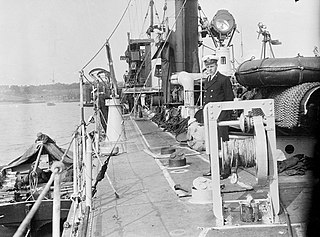
HMS Laforey was the lead ship of her class of destroyer built for the Royal Navy. Launched a year before the First World War began, she was attached to the Dover Patrol. Laforey saw action in several engagements with German torpedo boats, including the Battle off Noordhinder Bank and the action of 17 March 1917. Laforey was sunk in 1917 by a British mine after escorting several freighters to France. She was named for Francis Laforey, captain of HMS Spartiate at the Battle of Trafalgar in 1805.
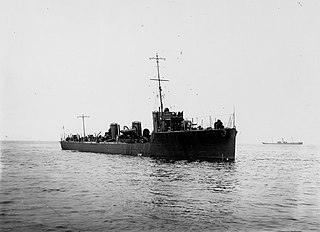
HMS Shark, was an Acasta-class destroyer built in 1912 for the Royal Navy. Shark was sunk during the Battle of Jutland on the evening of 31 May 1916.

HMS Minotaur was the lead ship of the Minotaur-class armoured cruisers built for the Royal Navy. Launched in 1906, she served as the flagship of the China Station before the First World War. Shortly after the war began, the ship searched unsuccessfully for the German East Asia Squadron and was transferred to the Grand Fleet at the end of 1914. During the rest of the war Minotaur served as the flagship of the 7th and 2nd Cruiser Squadrons and spent most of her time assigned to the Northern Patrol. In mid-1916 she participated in the Battle of Jutland but did not fire her weapons during the battle. The ship was paid off in 1919 and sold for scrap the following year.

HMS Carysfort was a C-class light cruiser built for the Royal Navy during World War I. She was one of six ships of the Caroline sub-class and was completed in 1915. Assigned to the Grand Fleet, the Harwich Force, and the Dover Patrol during the war, the ship served as a flagship for part of the war. Her only known combat was a short battle against German torpedo boats in the English Channel, although she was very active patrolling the North Sea and unsuccessfully searching for German ships. Carysfort was assigned to the Home and Atlantic Fleets after the war and was sent to the Mediterranean Fleet during the Chanak Crisis of 1922–23 to support British interests in Turkey. In 1922, she patrolled off the Irish coast during the Irish Civil War. The ship was placed in reserve after returning home in 1923 and, aside from ferrying troops overseas, remained in reserve until she was sold for scrap in 1931.
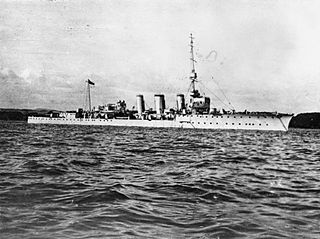
HMS Cordelia was a C-class light cruiser built for the Royal Navy during World War I. She was one of six ships of the Caroline sub-class and was completed at the beginning of 1915. The ship was assigned to the 1st and 4th Light Cruiser Squadrons (LCS) of the Grand Fleet for the entire war and played a minor role in the Battle of Jutland in mid-1916. Cordelia spent most of her time on uneventful patrols of the North Sea. She spent most of 1919 as a training ship before she was recommissioned for service with the Atlantic Fleet in 1920. The ship was placed in reserve at the end of 1922 and was sold for scrap in mid-1923.

The Active-class cruisers were a trio of scout cruisers built for the Royal Navy shortly before the First World War. They were initially assigned to the First Fleet and became destroyer flotilla leaders in 1914. Amphion and Fearless and their flotillas were assigned to the Harwich Force when the war began in August 1914. They went out on a patrol on the first day of the war and Amphion and her destroyers encountered and sank a German minelayer. On the voyage home, the cruiser struck a mine laid by the German ship and sank. She was the first ship of the Royal Navy to be sunk in the war.

HMS Active was the name ship of her class of three scout cruisers built for the Royal Navy in the 1910s. Completed in 1911, she was briefly assigned to several different units until the ship became the flotilla leader of the 2nd Destroyer Flotilla (DF) in 1914. When the First World War began in August of that year, the 2nd DF was assigned to the Grand Fleet where their primary task was to protect the fleet from submarines.
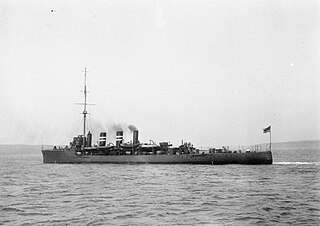
HMS Amphion was an Active-class scout cruiser built for the Royal Navy before the First World War. Completed in 1913, she was initially assigned to the First Fleet and became a destroyer flotilla leader in mid-1914. When the war began, her flotilla was assigned to the Harwich Force. While patrolling on the first full day of the war, Amphion and her destroyers encountered and sank a German minelayer, SMS Königin Luise, but not before she had laid many of her mines. While returning from patrolling the following morning, Amphion struck a mine on 6 August 1914 off the Thames Estuary and sank with the loss of 132 crewmen killed. She was the first ship of the Royal Navy to be sunk in the First World War. The wreck site is protected and may not be dived upon without permission from the Ministry of Defence.

HMS Fearless was one of three Active-class scout cruisers built for the Royal Navy shortly before the First World War. Upon completion in 1913, the ship was assigned to the 1st Light Cruiser Squadron (LCS) of the 1st Fleet. She became flotilla leader of the 1st Destroyer Flotilla (DF) shortly before the start of the war in August 1914 and was transferred to the Harwich Force shortly after it began. Fearless participated in the Battle of Heligoland Bight and the Cuxhaven Raid later that year. The ship was transferred to the Grand Fleet in early 1915 and played a minor role in the Battle of Jutland the following year.

HMS Blonde was the lead ship of her class of scout cruisers built for the Royal Navy in the first decade of the 20th century. She led the Seventh Destroyer Flotilla in the Mediterranean Fleet from completion until 1912. The ship was temporarily assigned to the First Destroyer Flotilla before she joined the Fourth Battle Squadron in 1913. During the First World War, Blonde was assigned to various battleship squadrons of the Grand Fleet. The ship was converted into a minelayer in 1917, but never actually laid any mines. She was reduced to reserve in 1919 and sold for scrap in 1920.

The Blonde-class cruisers were a pair of scout cruisers built for the Royal Navy in the first decade of the 20th century. Upon completion in 1910–11, they served as flotilla leaders for destroyer flotillas of the First Fleet until 1913 when they were assigned to battleship squadrons. When the First World War began in August 1914, they remained with their squadrons as the First Fleet was incorporated into the Grand Fleet, although they changed squadrons over the course of the war. Blonde did not participate in the Battle of Jutland in mid-1916, unlike her sister ship, Blanche, which did, but never fired a shot. They were converted into minelayers the following year, but only Blanche actually laid mines. The sisters were reduced to reserve in 1919 and sold for scrap in 1920–1921.

HMS Bellona was one of two Boadicea-class scout cruisers built for the Royal Navy in the first decade of the 20th century. The ship served as the flotilla leader for the 2nd Destroyer Flotilla from her completion in 1910 until 1913 when she was transferred to the 1st Battle Squadron. Bellona spent the bulk of World War I with that squadron. She was present at, but did not fight in, the Battle of Jutland in mid-1916. The ship was converted into a minelayer in mid-1917 and made four sorties to lay her mines before the end of the war. Bellona was reduced to reserve in 1919 and sold to be broken up for scrap in 1921.

HMS Boadicea was the lead ship of her class of scout cruisers built for the Royal Navy in the first decade of the 20th century. She led the 1st Destroyer Flotilla from completion until the ship was transferred to the 3rd Destroyer Flotilla in mid-1912. A year later Boadicea was reassigned to the 2nd Battle Squadron and she spent the bulk of World War I with that squadron. The ship was present at, but did not fight in, the Battle of Jutland in mid-1916. Boadicea was converted into a minelayer at the end of 1917 and made three sorties to lay her mines before the end of the war. She was placed in reserve after the war and taken out of service in 1920. The ship was used for harbour service at Dartmouth until she was sold for scrap in 1926.
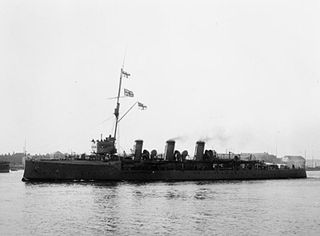
HMS Skirmisher was one of two Sentinel-class scout cruisers built for the Royal Navy during the first decade of the 20th century. Completed in 1905 the ship was placed in reserve until she was commissioned in 1907 as part of the Home Fleet. She then spent the next seven years moving on and off of active service in British waters. Skirmisher was assigned to coastal defence duties when the First World War began in 1914, although she was transferred to the Mediterranean in 1915 and then to the Aegean two years later. The ship returned home in mid-1919 and was sold for scrap in 1920.
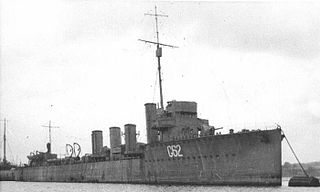
HMS Marksman was a Marksman-class flotilla leader of the British Royal Navy. Construction at Hawthorn Leslie's Newcastle upon Tyne shipyard began in 1914, shortly before the outbreak of the First World War, and the ship was launched and completed in 1915. She took part in the Battle of Jutland in 1916 and survived the war. She was sold for scrap in 1921.

HMS Laurel was a Laforey-class destroyer which served with the Royal Navy. Launched on 6 May 1913 as HMS Redgauntlet, the ship was renamed on 30 September under an Admiralty order to become one of the first alphabetical class destroyers. On commissioning, the vessel joined the 3rd Destroyer Flotilla and operated as part of the Harwich Force during the First World War. During Battle of Heligoland Bight, Laurel led a flotilla that pursued German torpedo boats, engaging with G194 and G196, and was damaged in action with the cruiser Mainz. The vessel also played a minor role in the Battles of Dogger Bank, Dover Strait and Jutland. With the cessation of hostilities, the ship was placed in reserve and scrapped on 1 November 1921.

HMS Mystic was an Admiralty M-class destroyer which served with the Royal Navy during the First World War. The M class was an improvement on the previous L class, capable of higher speed. The vessel, originally named HMS Myrtle but renamed before being launched in 1915, joined the Grand Fleet as part of the Eleventh Destroyer Flotilla. The ship was assigned as part of a destroyer screen to protect the British battleships as they sought to destroy the German High Seas Fleet. During the Battle of Jutland in 1916, the destroyer saw action against German light cruisers and, as the evening fell, attacked the German battle line, but recorded no hits. During the following year, the vessel took part in a large anti-submarine patrol, but did not see any German submarines. Later in the war, the ship was transferred to the Coast of Ireland Station at Buncrana and escorted convoys at the start of their journey from ports on the Clyde and Mersey or at the end of their journey across the Atlantic Ocean. After the Armistice in 1918 that marked the end of the First World War, Mystic was placed in reserve before being decommissioned and subsequently sold to be broken up in 1921.

HMS Morris was an Admiralty M-class destroyer which served with the Royal Navy during the First World War. The M class were an improvement on the preceding L class, capable of higher speed. The ship, the only vessel to be named Morris to serve with the Royal Navy, was launched on 19 November 1914. Joining the Grand Fleet as part of a new flotilla, the destroyer was soon in action, serving as part of a destroyer screen during the Battle of Dogger Bank in January 1915 and an escort to the minelayer Princess Margaret during a skirmish with German torpedo boats eight months later. At the Battle of Jutland in 1916, the destroyer was a crucial part of the flotilla that drove the German torpedo boats away from the British battlecruisers. Morris received no hits during these confrontations. The destroyer assisted in the rescue of survivors from the R-class destroyer Simoom and the recovery of the damaged flotilla leader Botha in 1917. The ship also undertook general duties including escorting merchant ships, minelayers, monitors, and the seaplane carrier Vindex. After the armistice that ended the war, the destroyer was considered superfluous to requirements, Initially placed in reserve, Morris was decommissioned and, on 8 November 1921, sold to be broken up.

















